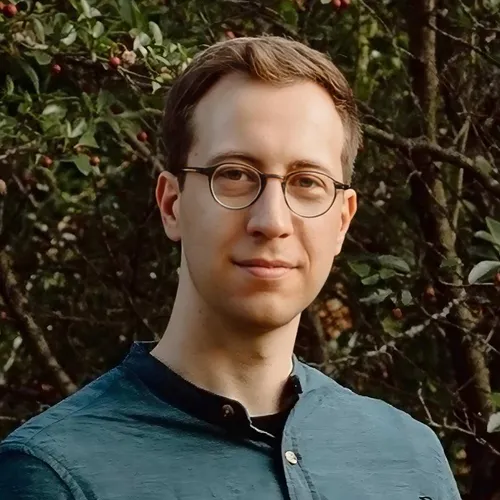
Justin Weiss is a composer and conductor whose music has been described as “lush, colorful” (Cleveland Classical) and full of “rustling energy” (Hyde Park Herald). His music explores the perception of time, energy, and transformation through collective textural play and melodically driven lyricism, immersing the listener in dramatic and vibrant sonic worlds. Much of Justin’s recent work has been focused on the translation and abstraction of visual arts and visual elements into sound.
Justin’s work has been recognized with a Charles Ives Scholarship from the American Academy of Arts and Letters, the League of Composers/ISCM Prize, the Prix Langage Musical from Les Écoles d’Art Américaines de Fontainebleau, the Walter E. Aschaffenburg Prize for Composition and awards and recognitions from institutions including ASCAP, Society of Composers, Inc., The American Prize, Tribeca New Music, YoungArts, and Encore Wind Ensemble. Justin will be a Composition Fellow at the Aspen Music Festival and School for the summer of 2025.
Justin’s music has been performed internationally by ensembles and musicians including Civic Orchestra of Chicago, Cleveland Chamber Symphony, Albany Symphony, Quatuor Diotima, Grossman Ensemble, TAK Ensemble, ~Nois Saxophone Quartet, Ekmeles Vocal Ensemble, Sandbox Percussion Quartet, Vertixe Sonora, VICE Ensemble, CHROMA Ensemble, Constantinides New Music Ensemble, Oberlin Contemporary Music Ensemble, Encore Wind Ensemble, Colin Currie, Huw Watkins, and Michael Foyle. Justin’s music has been presented at many festivals and conferences including Constellation Chicago, DiMenna Center, Ear Taxi Festival, North American Saxophone Alliance, Fontainebleau (FR), CHIMEFest, Red Note Music Festival, CAMPGround, VIPA (SP), and soundSCAPE (IT).
In addition to composing, Justin is an avid conductor, particularly in the realm of new music. He is the co-artistic/executive director and conductor for the new Chicago-based contemporary music ensemble, Mycelium New Music. He was previously the conductor of the University of Chicago New Music Ensemble and co-director of the Montclair State University New Music Ensemble. He has led performances with VICE Ensemble, Oberlin Sinfonietta and Contemporary Music Ensemble, and soundSCAPE Sinfonietta, and has premiered dozens of new works internationally. Justin studied conducting with Tim Weiss and Sian Edwards.
Justin studied at Oberlin Conservatory of Music and the Royal Academy of Music in London, where he was the recipient of the Dr. Mosco Carner Scholarship. Justin holds a PhD in Music Composition from the University of Chicago, where he studied with Augusta Read Thomas. Beginning Fall 2025, Justin will be a Visiting Assistant Professor at the Oberlin Conservatory of Music.
I have lately been fascinated by the work of the relatively unknown abstract expressionist artist, Norman Lewis. Compared with his contemporaries like Rothko or Pollock, Lewis is not featured in contemporary art exhibits across the world, yet his art speaks with volumes of intensity and power. I first came across Lewis' piece, Multitudes, which was tucked away in a corner of the “Art of the Americas” wing in the Art Institute of Chicago, but I was immediately allured by the layering of jagged lines and angular shapes over beautiful hues of melting color fields. In this work and many others by Lewis, a quasi-optical illusion forms; when attempting to focus on either the hues or the lines, the other is, in fact, drawn out even more. It’s as if the lines are in relief of the shadings and the shadings are in relief of the lines. The title of Lewis’ painting comes from Walt Whitman’s Songs of Myself :
“Do I contradict myself?/Very well then I contradict myself,/(I am large, I contain multitudes).”
In this piece, I drew on both the ideas of contrasting and layering lines and shadows as well as the balance of foreground and background as are both present in my experience of the painting. There are moments of multiple melodic shapes forming both a shadow and a composite melody; articulations against the melodic shape; linear melodies being drawn out into a harmonic field yet activated on the surface; or a focus on the angular melodies while a macro-harmonic motion evolves more slowly in the background. By having sections which draw attention towards certain elements foreground/background and jagged/hues dichotomies of the painting, I attempt to create my own “multitude” of experiences that all stem from one central, connected idea.
Justin Weiss
through depths and shadows continues a recent exploration of mine of the relationship between music and the visual arts. through depths and shadows was inspired by a fascinating and atypical piece by Jackson Pollock, The Deep, which I recently saw at the Pompidou Centre in Paris. Unlike many of his athletic and excited “drip paintings,” this one seemed to have a much more measured and slower energy. The painting seemed to layer large swaths of colors on the canvas—while also maintaining distinct lines, gestures, and shapes—allowing for the various colors to make their presence known or hidden depending on the other colors present. My experience of this piece was very different than what I usually experience with Pollock; rather than having dynamic and vibrant motion across the painting, I felt like I was continually sucked into the painting and attempting to find myself within the layers of the “deep.” Looking at this painting became an experience of continual exploration and uncovering. through depths and shadows is not a literal representation of the painting but an abstraction of both Pollock’s materials—his modes of layering, sporadic drips, and gradual unveiling—and my experience of continually searching within the shadings and underlayers of the painting. through depths and shadows was written with admiration for the incredible virtoisi of the Grossman Ensemble.